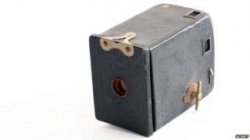Small Round cardboard boxes
 It doesn't look very exciting - a cardboard box about 5in (13cm) tall, covered in leatherette, with a small round opening at the front. You might have some trouble working out what it was for if you didn't know. But the Brownie might be the most important camera ever made, writes the BBC's Stephen Dowling.
It doesn't look very exciting - a cardboard box about 5in (13cm) tall, covered in leatherette, with a small round opening at the front. You might have some trouble working out what it was for if you didn't know. But the Brownie might be the most important camera ever made, writes the BBC's Stephen Dowling.
Before it appeared in 1900, cameras were distinctly unwieldy, if not downright cumbersome. Early cameras tended to be made of a great deal of brass and mahogany and took pictures on to large glass or metal plates, often requiring exposure times measured in minutes.
To photograph far-flung places, porters and pack animals were often needed to carry the equipment. Photography was an activity involving patience, toxic chemicals, and brute strength. It was not something the ordinary people indulged in.
The Brownie democratised photography simply through the sheer volume of salesMichael PritchardUS inventor George Eastman took an important step forward in the 1880s, when he popularised a flexible film that did away with the need for weighty plates. His first "Kodak Camera" went on sale in 1888, pre-loaded with enough film to take 100 photographs. When the last picture was taken, the entire camera was sent back to Kodak to be developed.
It was an uncomplicated box but it cost $25 - a significant amount of money. It was still a device for the wealthy.
The revolution came 12 years later. The Kodak Brownie, designed by Frank Brownell, looked similar to the original Kodak, but the film could be taken out of the camera after shooting and developed via Kodak stockists, chemists or even at home.
Image caption Brownies became a mass-market productAnd Kodak sold the camera for the princely sum of $1 - you could buy the camera, a film and have that film processed for just $2. Photography had suddenly become not only portable but affordable, too, and the Brownie was easy to use. It had a single shutter speed and narrow apertures that created deep depth of field. The lens could not be focused and early Brownies had only a basic viewfinder - many people just used marks on the top of the camera as a rough guide to what might be in the frame. You shot, and you hoped.
The Brownie is not a camera you're going to be blazing away at 10 frames a second withGary Cole"The Brownie democratised photography simply through the sheer volume of sales, " says Dr Michael Pritchard, president of the Royal Photographic Society and the author of The History of Photography in 50 Cameras, published in November.
"A $1 or 25-shilling camera capable of producing reasonable results was innovative, and coupled with Kodak's ability to provide directly or through an enormous number of chemists and photographic retailers a developing and printing service meant that photography became accessible irrespective of your social class or photographic skills."